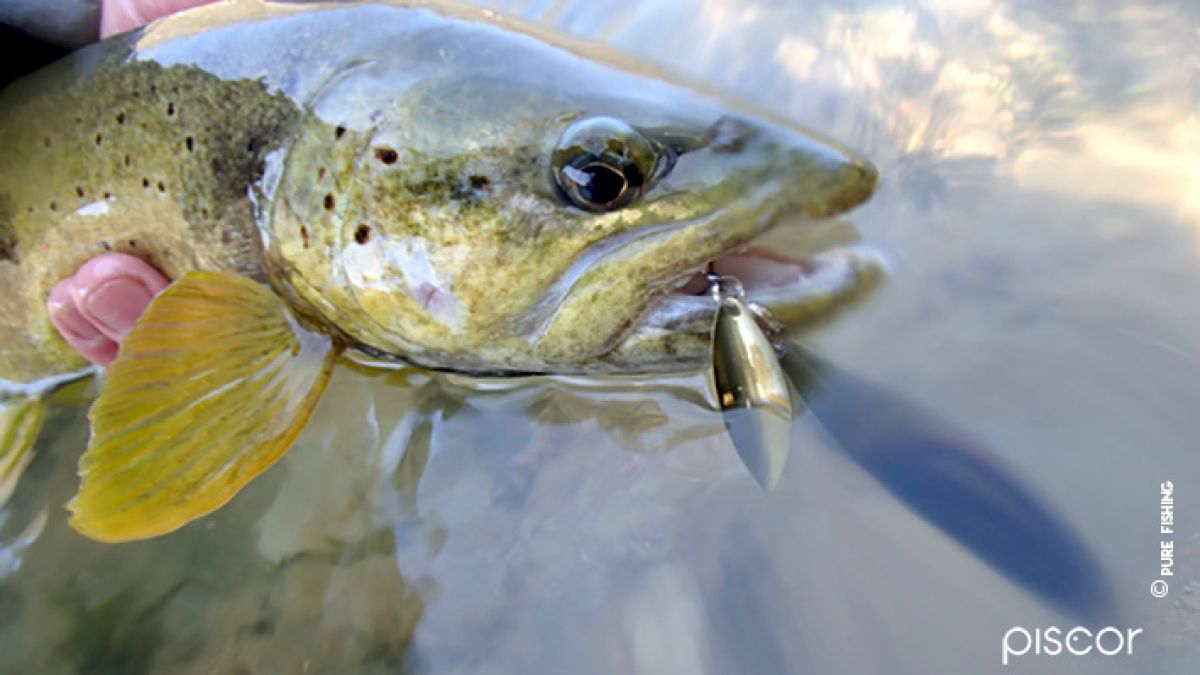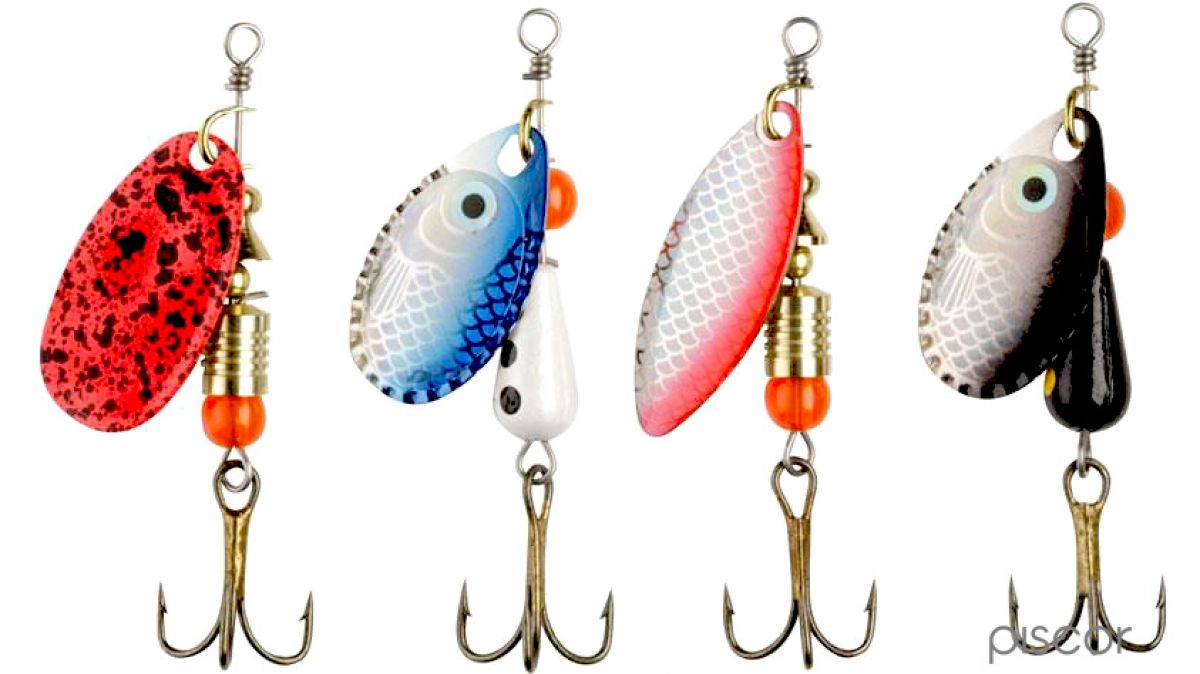Although the lures market continues to propose news and news it is really difficult to find a lure that contains characteristics of simplicity of construction, immediacy of use and effectiveness in terms of catches.
The spinner today still have all these features.
At Almost eighty years from its appearance on the market, this simple and functional lure continues to be the symbol of stream trout spinning.
We’ve already talked about the features of the spinner, about its story, about its mechanical functioning and any changes on the original model that during years has been proposed and accepted by enthusiasts.
Today we are going to see in a more specific way the use of this versatile lure in its favourite environment; the stream.
The stream is an extremely dynamic environment and its morphology varies both from the geological point of view and from the plant coverage in its descent from the source to the valley.
Therefore, to face up in the best way the different areas that characterizes it, it is good to know the different peculiarities that each spinner model has in order to make a valid and mindful choice when you have to connect your lure to the snap.
Which spoon you have to choose in different stretches of the stream? Let’s start from the top, in a virtual descent of a stream from the upper mountain areas in which we can let lower our baits.
In the first stretches the bed of the stream will be characterized by a pronounced declivity, reduced dimensions and low flow rate.
So we have to face shallow waters which runs fast in the midst of rocks and vegetation, having to search short stretches in which a lure can work.
This is a very difficult environment to tackle with the spinning technique but that can offer great satisfactions.
The most useful spinners will be those that will allow to fish for as long as possible in reduced spaces.
In this case will be very useful models as “martin” type and, where the speed in the water allow their use, we recommend the use “long” models with a long shovel.
The choice of the size is dictated by the speed of the water but also from the fact that the average dimensions of the preys will be almost reduced.
So you have to use the smallest spoon that will allow to fish.
By running down the environment is larger and variegated, fast currents alternates with shallow bottom areas, plains and holes.
The right spinners that can be used in the areas with faster currents are always the “martin” and “long” models while in the plains starts to find a space the classic models with a round shovel , the “French” shovel and also the small tandem.
In the holes the choice vary if these are the deepest areas of a plain, of a deep zone between big rocks that soften the current and that are fostered from secondary small slower currents or if we’re talking about a big hole under a little waterfall which receives violently the fast waters of the main current.
In the first case we can opt for a “martin” shovel, in this way we can pass quickly in front of the hole and after we can reduce speed bringing down the spoon or, alternatively, we can use a “French” shovel which, compared to the Martin, will have inevitably a heavier body and will take advantage of the vibrations transmitted to raise the trout on the bait during the passage above the hole.
On the deepest holes with weak current we can use a small spoon with round shovel and we can let it down almost up to the bottom for then recover it with a firm movement of the wrist on the rod.
In so doing the shovel will rotate only when the lure will be next to the bottom , that very often is the home of the bigger examples.
The most productive holes are usually the most difficult in which fish for, because they creates close to water jumps due to the presence of big rocks or of pronounced variations of bed’s inclination.
They are always “protected” by waterfalls and by the speed of the current, even if softened it is anyway elevated.
These are stretches of difficult interpretation because may arise some turns of secondary currents due to the nature of the pebbly stream bank.
The key word for the choice of a spoon that can be used in this case is: stay in fishing.
It is essential that our lure allows to present itself in the allocation areas of trouts by avoiding the risk that the current makes it jump outside the water or that invalidates the rotation of the shovel.
Obviously in these situations it is essential that the weight of the spinner is sufficient to maintain it in fishing but without exceeding because the bait could get stuck in the bottom.
Furthermore, heavy bodies corresponds to bigger shovels; that is increased surface that is subject to the friction of the current.
The right compromise could be to deal with these holes with “martin” type shovels of 4/6 g or “French” shovels of 2/3 (5/7 g).
Descending in the stretches into the valley, where the streams starts to take the river shapes or when they fall onto a lake, we can find less heterogeneous environments but wider.
In these cases will be appropriate to find the right combination between dimensions, weight and shape to best suit the need to cast at long distance, to maintain the lure in fishing and to not have a too heavy spoon that easily get stuck in the bottom or it is not always appreciated by trouts because it is too voluminous.
It must be said that also the medium size of preys is higher and it allow us to mainly indulge with models and dimensions.
The discourse on shapes/speed of the water it is rather clear now: if the current is faster we have to choose elongated shapes and reduced rotation angles.
So the “Martin” and “Long” type shovels which size are respectively of 4/6/9 g and 2/3 (5/7 g) have to be chosen if the current is fast, while if the water falls in a more relaxed way, maybe also soften by the rocks in secondary weak currents, you have to leave the space to “French” shovels of the 2 and 3 sizes, to the round shovels of 2 and 3 sizes and to tandem with 1-2 and 2-3 shovels.
So far we have talked about the standard models on the market, but, given the extreme simplicity of construction of these lures it is very simple to make some customizable changes .
The most classic one is that made on the Veltic, called “modified Veltic” which provides for the substitution of the original body with another one with an elongated shape which at its base are added some feathers.
This spinner is extremely valid to best cope with string currents in view of the weight of the body/shape/dimension of the shovel ratio.
For strong currents you can also modify any Martin type spoon simply increasing the weight of the body.
Therefore you can deal with a moderate current both with a classic Martin spoon of the size 4 or with a modified Martin with a body of 6 g and shovel of the size 2 by presenting a bait with a similar profile but with a much smaller shovel.
The same can be said for all types of spoons, while it will be difficult to make another one “lightened”.
Hence to make a spoon with a lighter body than the original one without losing its effectiveness in the rotation it will be essential to find the right compromise between the shape of the shovel and the mass of the body.
This type of spinners are very useful in shallow water areas because reduce the risk of sticking, even if, to best fish it is often necessary to use more voluminous spoon.
While they are fatal in slow waters to move big fishes by proposing a voluminous bait but at the same time which allows a more moderate and silent self-presentation .



